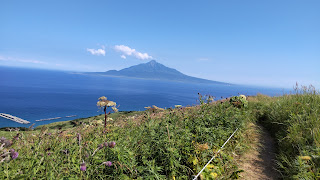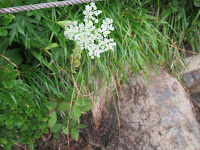On July 25, I set off the Narita airport to travel the northern part of Hokkaido together with my old friend. This was the first time that I used the LCC flight. Although this time of the year was usually the high season for tourists, there were many vacant seats in the Peach flight due to the pandemic and the government strict restrictions on travel. I could occupy all three seats in a row. This direct flight to Memanbetsu airport in Abashiri county took about 2 hours and cost me less than 10K yen, one thirds of those of major flights connecting to big cities in Hokkaido like Sapporo, Asahikawa and Hakodate, so really comfortable, cheap, and safe in terms of the panedemic. After landing, we immediately headed for a car rental service company and rented a car for 43,000 yen for 8 days. This was the start of my nostalgic tour to look over those mountains which more than a half century ago I climbed up with my university friends of the hiking club carrying tents. Back then we had crossed the Shiretoko peninsula over Mt. Raus and went up to the peak of Mt. Risiri on Risiri Island from the almost sea-level zone. Now this time, I was planning to see those mountais from the distance with nostalgic memories in my mind.
Mt. Raus
Mt. Risiri above the sea
My planned route to explore the northern part of Hokkaido is shown in the following map.
On the first night we stayed at the Youth Hostell that stood by the Lake Saroma, less than 50 km away from the airport.
Lake Saroma Wakka Nature Center
The next morning, on the way to Shiretoko, we dropped by the Lake Saroma Wakka Nature Center, which is the base for exploring the Wakka primeval flower garden. There are more than 300 species of the seaside plants including Hamanasu, rugosa rose on the long 20 km sand bar between the Sea of Okhotsk and the Lake Saroma. We could enjoy the quite moment strolling around the wild flower park with almost no visitors seen except us. A woman in the center said, "Unusully, they have had no rain for a month. Although the name of Wakka means "fresh water" in Ainu, most of flowers looked gone away.

Shiretoko national park
From the Wakka, we drove east on the national highway 244 to reach at noon to Raus, a fishing port, of which we had a panormic view from the nearby observatory. After taking a lunch with full of sea food products at a small restarunt, we further drove down toward the edge of the peninsular along the seashore overlooking Kunashiri Island, our legitimate territory siezed by Russia after the world war 2.

From Raus we took the National Route 334 dubbed as Shiretoko crossing road and crossed the Peninsula heading for Utoro. People can drive through this route only during the period between May and November due to the heavy snow accumulation in the other seasons. We continued to go up on the road with a succession of shap turns and reached the mountain pass called Rausu pass. It was unusually clear sunny day and we were so lucky to have a splendid view of Mt. Rausu (羅臼岳). More than a half century ago I climbed up to that peak from Rausu town carrying tents with my university friends. I remembered that we had walked cross the yellow river with sulfur, being cautious about meeting abruptly wild bears on the way, and taking a bath in the wild hotsprings at mid-night near the campsite.
From the pass we drove down to Utoro where we were going to stay for two nights to explore Shiretoko national park. Our lodging was called as “Shucho-no-ie”, meaning a chief of indigenous Ainu”, which was conveniently located to the ferry port.
Shiretoko Peninsula Cruising
The name of "Shiretoko" comes from the Ainu word that stands for "End of the Earth". The Shiretoko peninsula is 70 km long and 25 km wide at its base with the highest peak of Mt. Rausu, a stratovolcano, standing 1,661 m high above the sea level on the middle of the peninsula. Along the coastline on the western side, a row of cliffs shaply plunge into the sea, which had been formed by ice drifts eroding lava flows since the volcanic eruption of Mt. Rausu that first occurred more than 100K years ago. In 2005, Shiretoko was designated a World Natural Heritage site for its unique "Biodiversity". The area is home to varieties of land and marine animals and plant species. Salmon, marine mammals such as Steller's sea lions and cetaceans, sea birds such as spectacled guillemot, Steller's sea eagle, white-tailed sea eagle, and migratory birds. The diversity of these creatures as well as its unique fauna created by the interaction between ocean, river, and forest ecosystems have been attracting nature lovers from around the world.
In my planning, I decided to explore the area extensively in three different approaches, by walking in the forests, driving through high-ways to grasp the entire landscape, and using a ferry boat to have a view of the coastline from the sea side. So we got on board the small cruise ship to go to as far as Shiretoko Cape, the longest course among the three cruise options. We sat at the top front deck of the boat and felt as if we were rushing into the Sea of Okhotsk with an abundant of marine blessings like adventurers. We were also looking to see the Shiretoko brown bears strolling along the unmanned beach searching for food.

Shiretoko Goko Lakes (知床五湖)
After taking lunch at a tavern-like restraunt near to the ferry boat, we headed to Shiretoko Goko Lakes, five small and mysterious lakes sleeping in the forest at the foot of Mt.Rausu, hoping to better understand the fauna created by the interactions between volcanic activities and the Sea of Okhotsk as well as enjoying the promenade around five lakes. This is the protected area to preserve the biological diversity for future generations, administered by the Japanese government . At the Shiretoko Nature Center we were told that during the period from May to July when brown bears become most active in a year, hikers are not allowed to step in the area without a guide. So we had no other choice to take part in this guided ecological tour. The guide who led us, 6 people in total, explained us about how the 5 lakes had been formed and what kind of animals and plants we could observe on the way. He sometimes shouted loudly toward the deep forest in order to let bears to know that some human beings might be approching to them. According to him, once at least one brown bear is witnessed, all the hikers within the area are required to immediately stop walking and return to the entrance gate quickly. He emphasized that this was not the tour to show visitos wild bears, but to guide them safely not to meet bears. His explanation reminded me of one mountain ranger in Rocky Mountains, Canada around 10 years ago. She told me that they were really concerned about bears and tring so hard to protect them from human beings. She emphasised that she was trying to protect bears, not hikers. The lakes were extremely quite with the mysterious atmosphere. But I was a little bit of disappointed with no bears in sight of me.

Furepe waterfall trail
The next morning, we decided to visit the Furepe waterfall trail closely located to the Shiretoko Goko Lakes to enjoy morning promnaude again in Shiretoko before heading north for Hamatonbetsu-chou, a coastal town along the Sea of Okhotsk. This waterfall has no river to pump out water into the sea from the top crack on the cliff, 100 m high above the sea level. The accumulated snow and rain on Shiretoko mountain ranges penetrate into the ground and we see that underground water dripping down into the Sea of Okhotsk as if tears rolling down on a young girl's cheeks. That's why this fall is dubbed as "Tears of a young lady". From the entrance gate of Shiretoko nature center, it took us only 20 minutes to reach the outlook for the fall. There were no other visitors in the natural park except us at the time we entered. On the way, I once shouted out looking ahead because I felt as if some animals like bears were hiding behind the bush, but we were astounded to see a family of deers emerging abruptly in the nearest bush. They looked like taking a lunch peacefully and didn't like to be bothered by human beings.






































































